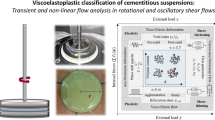Abstract
A theoretical frame able to describe the segregation under gravity of a mono-sized granular material in a yield stress suspending fluid is presented. Two stability criteria are proposed. The first one deals with the stability of a single sphere in a yield stress fluid while the second one takes into account the mechanical interactions between the particles that could lower the risk of instability. The two criteria are then experimentally validated in the case of polystyrene spheres in a cement paste. Image analysis techniques are used to measure the final solid fraction in the segregated zone. The comparison of the experimental and theoretical results is followed by an analysis of the possible use of such criteria in a mix proportioning method and a short discussion of the influence of the change of rheological properties with time on the segregation phenomenon.
Similar content being viewed by others
References
Okamura H, Ozawa K (1995) Mix design for self-compacting concrete. Proc. of JSCE Concrete Library International 25:107–120.
Billberg P (2003) Form pressure generated by self-compacting concrete. Proceedings of the 3rd international RILEM Symposium on Self-Compacting Concrete, Reykjavik, Iceland, (RILEM PRO33), pp. 271–280.
Wallevik O (2003) Rheology–-a scientific approach to develop self-compacting concrete. Proceedings of the 3rd international RILEM Symposium on Self-Compacting Concrete, Reykjavik, Iceland, (RILEM PRO33), pp. 23–31.
De Larrard F (1999) Concrete mixture proportioning. E & FN Spon, London.
Saak AW, Jenning H, Shah S (2001) New methodology for designing self-compacting concrete. ACI materials Journal 98(6):429–439.
Cussigh F, Sonebi M, De Schutter G (2003) Project testing SCC-segregation test methods. Proceedings of the 3rd international RILEM Symposium on Self-Compacting Concrete, Reykjavik, Iceland, (RILEM PRO33), pp. 311–322.
Daczko JA (2003) A comparison of passing ability test methods for self consolidating concrete. Proceedings of the 3rd international RILEM Symposium on Self-Compacting Concrete, Reykjavik, Iceland, (RILEM PRO33), pp. 335–344.
He YB, Laskowski JS, Klein B (2001) Particle movement in non-Newtonian slurries: the effect of yield stress on dense medium separation. Chemical Engineering Science 56:2991–2998.
Ansley RW, Smith TN (1967) Motion of spherical particles in a Bingham plastic. A.I.Ch.E. Journal 13:1193–1196.
Batchelor GK (1967) An introduction to fluid mechanics. Cambridge University Press, Cambridge.
Bethmond S, d'Aloïa Schwarzentruber L, Stefani C, Le Roy R (2003) Defining the stability criterion of a sphere suspended in a cement paste: a way to study the segregation risk in self compacting concrete (SCC). Proceedings of the 3rd international RILEM Symposium on Self-Compacting Concrete, Reykjavik, Iceland, (RILEM PRO33), pp. 94–105.
Du Plessis MP, Ansley RW (1967) J. Pipeline Division (ASCE) 2(1).
Hill R (1950) The mathematical theory of plasticity. Oxford University Press, Oxford.
Dontula P, Macosko CW (1999) Yield stress of Orbitz. Rheology Bulletin 68(1):5–6.
Beris AN, Tsamopoulos JA, Armstrong RC, Brown RA (1985) Creeping motion of a sphere through a Bingham plastic. Journal of Fluid Mechanics 158:219–244.
Petrou MF, Wan B, Galada-Maria F, Kolli VG, Harries KA (2000) Influence of mortar rheology on aggregate settlement. ACI Materials Journal 97(4):479–485.
Petrou MF, Harries KA, Galada-Maria F, Kolli VG (2000) A unique experimental method for monitoring aggregate settlement in concrete. Cem. Conc. Res. 30:809–816.
Jossic L, Magnin A (2001) Traînée et stabilité d'objet en fluide à seuil. les cahiers de rhéologie 18(1). (Only available in French).
Chhabra RP (1993) Bubbles, drops, and particles in non-Newtonian flows. CRC Press, Boca Raton, Florida, USA.
Bürger R (2000) Phenomenological foundation and mathematical theory of sedimentation–consolidation processes. Chemical Engineering Journal 80:177–188.
Roussel N, Lanos C (2004) Particle fluid separation in shear flow of dense suspensions: experimental measurements on squeezed clay pastes. Appl. Rheol. 14:256–265.
Yang SM, Leal LG, Kim YS (2002) Hydrodynamic interaction between spheres coated with deformable thin liquid films. Journal of Colloid and Interface Science 250:457–465.
Rodin GJ (1996) Squeeze film between two spheres in a power-law fluid. J. Non-Newtonian Fluid Mech. 63:141–152.
Banfill PFG, Saunders DC (1981) On the viscosimetric examination of cement pastes. Cem. Conc. Res. 11:363–370.
Caufin B, Papo A (1983) Rheological testing methods for gypsum plaster pastes. RILEM materials and structures 95:315–321.
Nguyen QD, Boger DV (1985) Direct yield stress measurement with the vane method. J. Rheol. 29:335–347.
Rasband W, ImageJ, Image processing and analysis in Java. downloadable on the ImageJ homepage (http://rsb.info.nih.gov/ij/).
Lei WG, Struble LJ (1997) Microstructure and flow behaviour of fresh cement paste. J. Am. Ceram. Society 80(8):2021–2028.
Roussel N (2005) Fresh cement paste steady and transient flow behaviour. Cem. Conc. Res. (Accepted for publication).
Author information
Authors and Affiliations
Rights and permissions
About this article
Cite this article
Roussel, N. A Theoretical Frame to Study Stability of Fresh Concrete. Mater Struct 39, 81–91 (2006). https://doi.org/10.1617/s11527-005-9036-1
Received:
Accepted:
Published:
Issue Date:
DOI: https://doi.org/10.1617/s11527-005-9036-1




